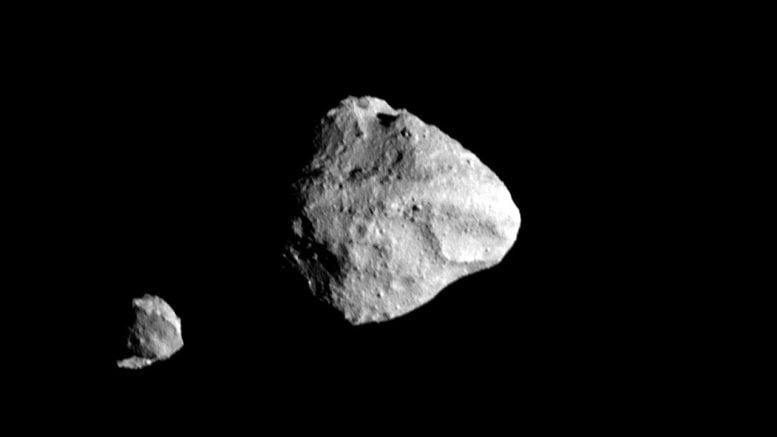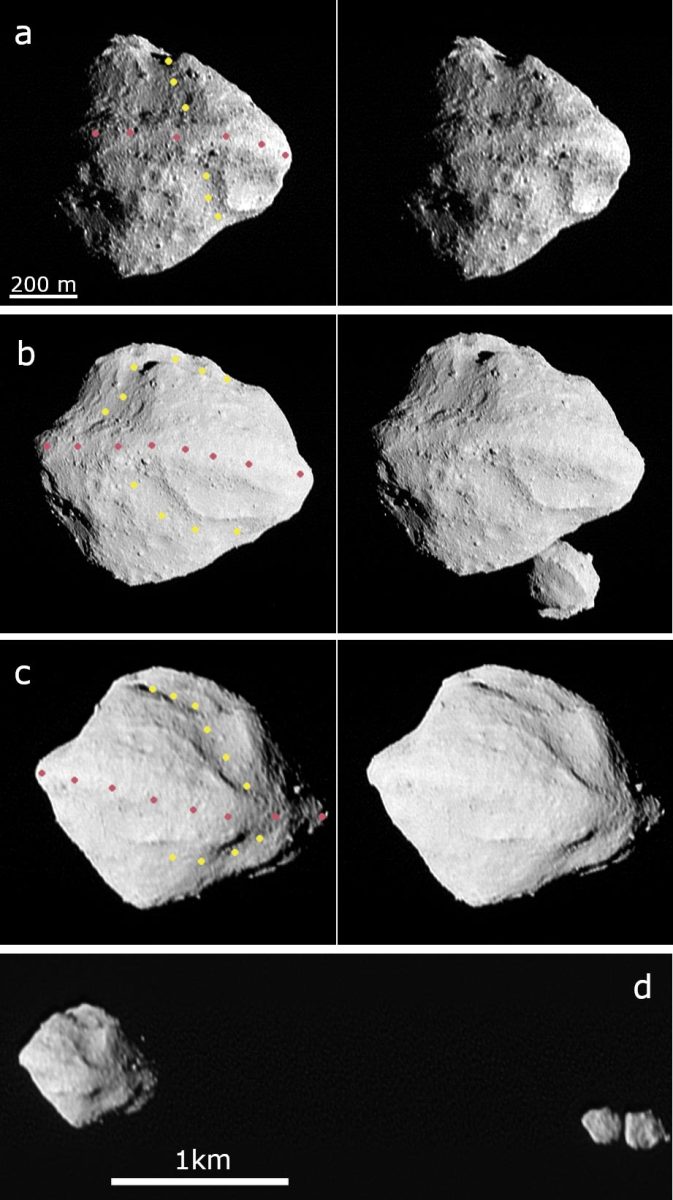NASA’s Lucy Unveils a Surprising Discovery


NASA’s Lucy spacecraft’s recent exploration of asteroid Dinkinesh not only highlighted the asteroid’s internal complexities but also led to a fascinating discovery: the formation of a double moon, Selam. This rare configuration, known as a contact binary, formed from debris orbiting Dinkinesh after a significant geological event. Credit: NASA/SwRI/Johns Hopkins APL/NOIRLab
NASA’s Lucy spacecraft’s November 2023 flyby of asteroid Dinkinesh revealed significant geological features indicating its internal strength and complex history. Images showed a trough, a ridge, and a contact binary satellite, Selam. These findings, suggesting that Dinkinesh responded dynamically to stress over millions of years, help scientists understand the formation and evolution of small bodies in the solar system.
Images from the November 2023 flyby of asteroid Dinkinesh by NASA’s Lucy spacecraft reveal intriguing details. They show a trough on Dinkinesh where a large piece — about a quarter of the asteroid — suddenly shifted, a ridge, and a separate contact binary satellite (now known as Selam). Scientists say this complicated structure shows that Dinkinesh and Selam have significant internal strength and a complex, dynamic history.

Panels a, b, and c each show stereographic image pairs of the asteroid Dinkinesh taken by the NASA Lucy Spacecraft’s L’LORRI Instrument in the minutes around closest approach on Nov. 1, 2023. The yellow and rose dots indicate the trough and ridge features, respectively. These images have been sharpened and processed to enhance contrast. Panel d shows a side view of Dinkinesh and its satellite Selam taken a few minutes after closest approach. Credit: NASA/SwRI/Johns Hopkins APL/NOIRLab
“We want to understand the strengths of small bodies in our solar system because that’s critical for understanding how planets like Earth got here,” said Hal Levison, Lucy principal investigator at the Boulder, Colorado, branch of the Southwest Research Institute in San Antonio, Texas. “Basically, the planets formed when zillions of smaller objects orbiting the Sun, like asteroids, ran into each other. How objects behave when they hit each other, whether they break apart or stick together, has a lot to do with their strength and internal structure.” Levison is lead author of a paper on these observations published recently in the journal Nature.
On November 1, 2023, NASA’s Lucy spacecraft flew by the main-belt asteroid Dinkinesh. Now, the mission has released pictures from Lucy’s Long Range Reconnaissance Imager taken over a roughly three-hour period, providing the best views of the asteroid to date. During the flyby, Lucy discovered that Dinkinesh has a small moon, which the mission named “Selam,” a greeting in the Amharic language meaning “peace.” Lucy is the first mission designed to visit the Jupiter Trojans, two swarms of asteroids trapped in Jupiter’s orbit that may be “fossils” from the era of planet formation. Credit: NASA’s Goddard Space Flight Center
Dinkinesh’s Composition and Behavior
Researchers think that Dinkinesh is revealing its internal structure by how it has responded to stress. Over millions of years rotating in the sunlight, the tiny forces coming from the thermal radiation emitted from the asteroid’s warm surface generated a small torque that caused Dinkinesh to gradually rotate faster, building up centrifugal stresses until part of the asteroid shifted into a more elongated shape. This event likely caused debris to enter into a close orbit, which became the raw material that produced the ridge and satellite.

Stereo movie of asteroid Dinkinesh from NASA’s Lucy spacecraft flyby on November 1, 2023. Credit: NASA/GSFC/SwRI/Johns Hopkins APL/NOIRLab/Brian May/Claudia Manzoni
If Dinkinesh were much weaker, more like a fluid pile of sand, its particles would have gradually moved toward the equator and flown off into orbit as it spun faster. However, the images suggest that it was able to hold together longer, more like a rock, with more strength than a fluid, eventually giving way under stress and fragmenting into large pieces. (Although the amount of strength needed to fragment a small asteroid like Dinkinesh is minuscule compared to most rocks on Earth.)
Structural Features and Historical Reconstruction
“The trough suggests an abrupt failure, more an earthquake with a gradual buildup of stress and then a sudden release, instead of a slow process like a sand dune forming,” said Keith Noll of NASA’s Goddard Space Flight Center in Greenbelt, Maryland, project scientist for Lucy and a co-author of the paper.
“These features tell us that Dinkinesh has some strength, and they let us do a little historical reconstruction to see how this asteroid evolved,” said Levison. “It broke, things moved apart and formed a disk of material during that failure, some of which rained back onto the surface to make the ridge.”

Stereo movie of Selam from NASA’s Lucy spacecraft flyby on Nov. 1, 2023. Credit: NASA/GSFC/SwRI/Johns Hopkins APL/NOIRLab/Brian May/Claudia Manzoni
The researchers think some of the material in the disk formed the moon Selam, which is actually two objects touching each other, a configuration called a contact binary. Details of how this unusual moon formed remain mysterious.
Future Missions
Dinkinesh and its satellite are the first two of 11 asteroids that Lucy’s team plans to explore over its 12-year journey. After skimming the inner edge of the main asteroid belt, Lucy is now heading back toward Earth for a gravity assist in December 2024. That close flyby will propel the spacecraft back through the main asteroid belt, where it will observe asteroid Donaldjohanson in 2025, and then on to the first of the encounters with the Trojan asteroids that lead and trail Jupiter in its orbit of the Sun beginning in 2027.
Reference: “A contact binary satellite of the asteroid (152830) Dinkinesh” by Harold F. Levison, Simone Marchi, Keith S. Noll, John R. Spencer, Thomas S. Statler, James F. Bell III, Edward B. Bierhaus, Richard Binzel, William F. Bottke, Daniel Britt, Michael E. Brown, Marc W. Buie, Philip R. Christensen, Neil Dello Russo, Joshua P. Emery, William M. Grundy, Matthias Hahn, Victoria E. Hamilton, Carly Howett, Hannah Kaplan, Katherine Kretke, Tod R. Lauer, Claudia Manzoni, Raphael Marschall, Audrey C. Martin, Brian H. May, Stefano Mottola, Catherine B. Olkin, Martin Pätzold, Joel Wm. Parker, Simon Porter, Frank Preusker, Silvia Protopapa, Dennis C. Reuter, Stuart J. Robbins, Julien Salmon, Amy A. Simon, S. Alan Stern, Jessica M. Sunshine, Ian Wong, Harold A. Weaver, Coralie Adam, Shanti Ancheta, John Andrews, Saadat Anwar, Olivier S. Barnouin, Matthew Beasley, Kevin E. Berry, Emma Birath, Bryce Bolin, Mark Booco, Rich Burns, Pam Campbell, Russell Carpenter, Katherine Crombie, Mark Effertz, Emily Eifert, Caroline Ellis, Preston Faiks, Joel Fischetti, Paul Fleming, Kristen Francis, Ray Franco, Sandy Freund, Claire Gallagher, Jeroen Geeraert, Caden Gobat, Donovan Gorgas, Chris Granat, Sheila Gray, Patrick Haas, Ann Harch, Katie Hegedus, Chris Isabelle, Bill Jackson, Taylor Jacob, Sherry Jennings, David Kaufmann, Brian A. Keeney, Thomas Kennedy, Karl Lauffer, Erik Lessac-Chenen, Rob Leonard, Andrew Levine, Allen Lunsford, Tim Martin, Jim McAdams, Greg Mehall, Trevor Merkley, Graham Miller, Matthew Montanaro, Anna Montgomery, Graham Murphy, Maxwell Myers, Derek S. Nelson, Adriana Ocampo, Ryan Olds, John Y. Pelgrift, Trevor Perkins, Jon Pineau, Devin Poland, Vaishnavi Ramanan, Debi Rose, Eric Sahr, Owen Short, Ishita Solanki, Dale Stanbridge, Brian Sutter, Zachary Talpas, Howard Taylor, Bo Treiu, Nate Vermeer, Michael Vincent, Mike Wallace, Gerald Weigle, Daniel R. Wibben, Zach Wiens, John P. Wilson and Yifan Zhao, 29 May 2024, Nature.
DOI: 10.1038/s41586-024-07378-0
Lucy’s principal investigator is based out of the Boulder, Colorado, branch of Southwest Research Institute, headquartered in San Antonio. NASA’s Goddard Space Flight Center in Greenbelt, Maryland, provides overall mission management, systems engineering, and safety and mission assurance. Lockheed Martin Space in Littleton, Colorado, built and operates the spacecraft. Lucy is the 13th mission in NASA’s Discovery Program. NASA’s Marshall Space Flight Center in Huntsville, Alabama, manages the Discovery Program for the Science Mission Directorate at NASA Headquarters in Washington.

